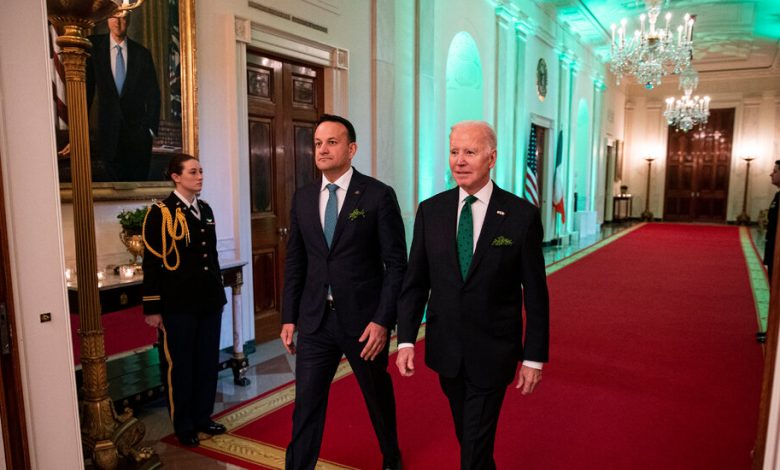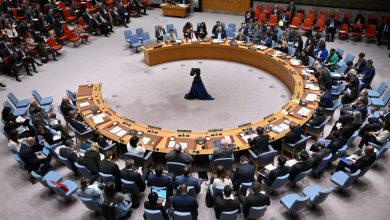Biden Must Tread Rocky Path in Belfast Before Tending His Irish Roots

When President Biden visits his family’s ancestral home in Ireland this week, he will walk a path trod by many American presidents — a joyful, politically uncomplicated journey that mixes shamrock-sprinkled nostalgia with odes to the enduring bond between the Irish and Americans.
But first, Mr. Biden must pick his way through Northern Ireland, where the political landscape is rockier and the memories darker.
That is particularly true for a president who is a proud son of the Emerald Isle, fond of quoting poets like Yeats and Seamus Heaney, and occasionally his own great-grandfather, Edward Francis Blewitt, whose poems are suffused with Irish republican sentiment. “Being Irish has shaped my entire life,” Mr. Biden once said.
In Belfast, the president will mark the 25th anniversary of the Good Friday Agreement, which ended decades of sectarian violence in Northern Ireland. The accord is a cherished diplomatic legacy of another Democratic president, Bill Clinton — one that showcased his skill as a mediator between the nationalists, who seek a united Ireland, and the unionists, who want to remain part of the United Kingdom.
In early April 1998, Mr. Clinton worked the phones at the White House, whittling down the last barriers to a deal that satisfied the unionist leader, David Trimble, as well as the two key nationalists, John Hume, the leader of the Social Democratic and Labour Party, and Gerry Adams, the leader of Sinn Fein.
“Clinton stayed up all night for two nights talking to Adams, Hume and Trimble,” said Jonathan Powell, who, as chief of staff to Prime Minister Tony Blair, led the negotiations on behalf of the British government.
Mr. Biden approaches Irish issues from a sentimental rather than a diplomatic perspective. “Biden has an interest in it,” Mr. Powell said. “It’s not necessarily a live political interest, but a historical family interest in Ireland.”
Critics say Mr. Biden’s Irish pride has occasionally led him to take sides. As a senator in 1985, he spoke out against making it easier to extradite Irish Republican Army militants from the United States to Britain.
Though Mr. Biden deplored I.R.A. terrorism and supported the peace process as a member of the Senate Foreign Relations Committee, he was not visibly linked to it like his former Senate colleague George J. Mitchell, who presided over the Good Friday negotiations as Mr. Clinton’s special envoy.
What to Know About ‘the Troubles’
A history of violence. “The Troubles” is a term used to describe a decades-long sectarian conflict in Northern Ireland, a region that was carved out as a Protestant-majority enclave under British sovereignty when the Republic of Ireland became self-governing in the 1920s. The conflict pitted those who wanted unity with Ireland — mostly Catholic, and known as nationalists and republicans — against those who wanted the territory to remain part of the United Kingdom — mostly Protestant, and known as unionists and loyalists.
How ‘the Troubles’ began. A civil rights march in the city of Derry on Oct. 5, 1968, is often referred to as a catalyst for the Troubles. The demonstration was banned after unionists announced plans for a rival march, but the organizers resolved to go ahead with it. When officers from the Protestant-dominated police force surrounded the demonstrators with batons drawn and sprayed the crowd with a water cannon, rioting erupted.
Simmering tensions. Centuries of disaffection quickly turned to armed revolt spearheaded by the underground Irish Republican Army and its political wing, Sinn Fein, which cast themselves as champions of the Roman Catholic minority. Loyalist paramilitary groups challenged the I.R.A., supposedly to protect a Protestant majority, injecting one more element of violence into the war.
Bloody Sunday. On Jan. 30, 1972, thousands of mostly Catholic marchers took to the streets of the Bogside district of Derry in opposition to a new policy of detention without trial. British soldiers opened fire, killing 14 protesters. The events became one of the most infamous episodes of the Troubles, known as Bloody Sunday.
A far-reaching conflict. The conflict had all the appearances of a civil war, with roadblocks, bomb blasts, sniper fire and the suspension of civil rights. Bombings also spread to the rest of Britain, and British troops hunted down I.R.A. members as far afield as Gibraltar. The I.R.A. drew significant support from groups as disparate as Irish Americans in the United States and the Libyan dictator Col. Muammar el-Qaddafi.
How the Troubles ended. The conflict came formally to an end in 1998 with a settlement known as the Good Friday Agreement. As part of the deal, a new form of regional government was created to share power between those who wanted the region to remain part of the United Kingdom and those who sought a united Ireland.
The conflict’s long shadow. Even after the Good Friday Agreement brought a form of peace, some violence has persisted. The shared executive authority set up in the 1998 accord has also seen repeated suspensions because of intractable disputes between the two sides and, most recently, the fallout from Brexit.
Mr. Powell said Mr. Biden had made his own contribution later on by pressing the British government to break an impasse with the European Union over post-Brexit trade rules for Northern Ireland. The dispute jeopardized the Good Friday Agreement because it prompted the main pro-unionist party, the Democratic Unionists, to leave the power-sharing government in the North.
In February, Prime Minister Rishi Sunak of Britain announced a deal with Brussels, known as the Windsor Framework. In doing so, he fulfilled a promise he made to Mr. Biden when the two met last fall at a summit in Indonesia, during which the prime minister vowed to resolve the issue.
On Wednesday in Belfast, Mr. Biden will greet the leaders of Northern Ireland’s five political parties, including the Democratic Unionists, who have yet to support the trade deal or agree to return to the government. Whether he will be able to cajole them to go back will be a test of his influence.
“It is possible that Biden could be seen as adding more pressure on the unionists,” said Katy Hayward, a professor of politics at Queen’s University in Belfast. “Rather than coming with a hammer, a bit of evenhanded encouragement would be very useful.”
Mr. Biden will bring along a sweetener in the form of a new special envoy for economic affairs to Northern Ireland, Joe Kennedy III. Mr. Kennedy, a former Democratic representative from Massachusetts and a scion of one of the most famous Irish American families, is charged with drumming up foreign investment in the territory.
Some unionists view Mr. Biden and Mr. Kennedy warily, though they stop short of saying that the administration is tilted against them.
“Bill Clinton was evenhanded; George W. Bush was evenhanded,” Jeffrey Donaldson, the leader of the Democratic Unionists, said in an interview. “Any president who is going to support the peace process has got to be evenhanded.”
Mr. Powell, however, played down the importance of Mr. Biden’s Irish identity, noting that the United States was not likely to play a mediating role in Northern Ireland. Even Mr. Clinton, he said, infuriated the British government in 1994 by granting Mr. Adams, the Sinn Fein leader, a visa to visit the United States.
Still, Mr. Biden’s Ireland-heavy itinerary has raised questions about his priorities. He is skipping a larger gathering of leaders, including King Charles III, Mr. Clinton and Mr. Blair, next week in Belfast to celebrate the Good Friday Agreement.
While Mr. Biden will meet Mr. Sunak, the White House has pushed to scale back the session from a bilateral meeting to a less formal coffee. That prompted a wisecracking junior State Department official to dub it a “bi-latte.”
These squabbles over protocol can send a message, diplomats said, particularly because Mr. Biden also plans to skip the coronation of King Charles next month, sending his wife, Jill, in his place. White House officials said Mr. Biden had accepted the king’s invitation to make a state visit to Britain, though no date has been set.
Mr. Biden will spend less than 24 hours in Belfast, leaving for Dublin right after he speaks at Ulster University. Once in Ireland, he will tour ancestral sites in County Louth and County Mayo, where, the White House said, he would “deliver an address to celebrate the deep, historic ties that link our countries and people.”
That is certain to be the emotional highlight of the trip, and Irish officials are licking their lips in anticipation. For them, Mr. Biden’s involvement in Irish affairs is thoroughly welcome. They credit his pressure on the British government with helping to produce a trade agreement on Northern Ireland. And they view America’s continued involvement as key to improving the prosperity of the North.
“The United States has skin in this game,” said Mary Lou McDonald, the leader of Sinn Fein in the Irish Republic. “The Irish peace process is one of the really big American foreign policy triumphs of recent times. I don’t think it would be real or helpful for the United States to stand off now.”
“It helps that President Biden is a Mayo man, with connections in County Louth,” Ms. McDonald added. “So, he has a particular understanding of and takes a particular interest in Ireland, which is great.”




